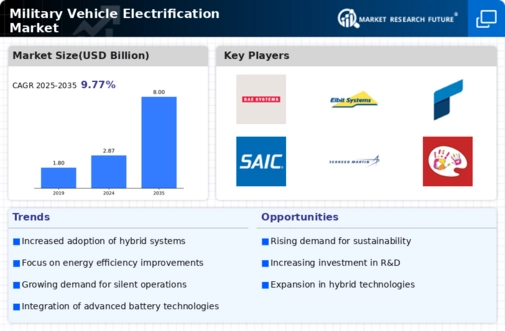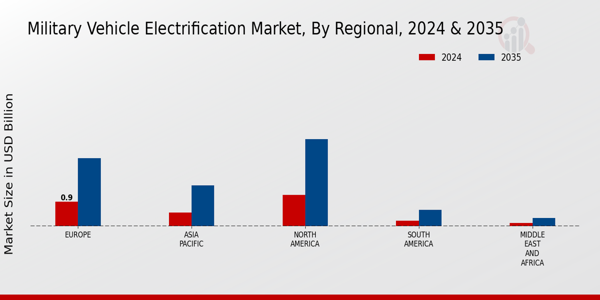Market Growth Projections
The Global Military Vehicle Electrification Market Industry is projected to experience substantial growth over the next decade. The market is expected to expand from 2.87 USD Billion in 2024 to 8 USD Billion by 2035, indicating a robust demand for electrified military solutions. This growth trajectory is supported by various factors, including technological advancements, government initiatives, and increasing operational requirements. The anticipated compound annual growth rate of 9.77 percent from 2025 to 2035 further underscores the market's potential. As military organizations continue to prioritize modernization and sustainability, the electrification of vehicles is likely to become a central focus in defense strategies.
Government Initiatives and Funding
Government initiatives and funding play a crucial role in shaping the Global Military Vehicle Electrification Market Industry. Many nations are investing heavily in electrification projects to modernize their military fleets. For instance, the U.S. Department of Defense has allocated significant resources to develop electric and hybrid military vehicles, aiming to enhance operational capabilities while reducing environmental impact. Such initiatives not only promote technological innovation but also stimulate economic growth within the defense sector. The expected compound annual growth rate of 9.77 percent from 2025 to 2035 underscores the importance of government support in driving the electrification agenda.
Increasing Demand for Energy Efficiency
The Global Military Vehicle Electrification Market Industry is witnessing a growing emphasis on energy efficiency. Military organizations are increasingly seeking to reduce fuel consumption and operational costs. Electrification of military vehicles offers a pathway to achieve these objectives. For instance, the integration of hybrid and fully electric systems can lead to a reduction in fuel usage by up to 50 percent in certain applications. This shift not only enhances operational readiness but also aligns with sustainability goals. As a result, the market is projected to reach 2.87 USD Billion in 2024, reflecting the urgent need for energy-efficient solutions in military operations.
Growing Focus on Operational Versatility
The Global Military Vehicle Electrification Market Industry is characterized by a growing focus on operational versatility. Electrified military vehicles can be deployed in a variety of roles, from combat to logistics, enhancing their utility across different missions. This versatility is particularly important in modern warfare, where adaptability is crucial. For instance, hybrid vehicles can operate silently in electric mode for reconnaissance missions, while still having the capability to switch to conventional power for high-speed maneuvers. This adaptability is likely to drive demand, contributing to the anticipated market growth, as military forces seek to optimize their fleets for diverse operational scenarios.
Technological Advancements in Battery Systems
Technological advancements in battery systems are driving the Global Military Vehicle Electrification Market Industry forward. Innovations in lithium-ion and solid-state batteries are enhancing energy density and reducing charging times. These improvements enable military vehicles to operate longer on a single charge, thus increasing their operational effectiveness. For example, the latest battery technologies can provide a range of over 300 miles for electric military vehicles, making them viable for various missions. As the market evolves, the anticipated growth from 2.87 USD Billion in 2024 to 8 USD Billion by 2035 indicates a robust demand for advanced battery solutions in military applications.
Environmental Regulations and Sustainability Goals
The Global Military Vehicle Electrification Market Industry is increasingly influenced by stringent environmental regulations and sustainability goals. Governments worldwide are mandating reductions in greenhouse gas emissions, prompting military organizations to adopt cleaner technologies. Electrification of military vehicles aligns with these regulatory frameworks, offering a means to achieve compliance while enhancing operational efficiency. For example, the European Union has set ambitious targets for reducing emissions, which directly impacts military procurement strategies. As the market adapts to these requirements, the projected growth from 2.87 USD Billion in 2024 to 8 USD Billion by 2035 reflects the urgency of integrating sustainable practices within military operations.




















